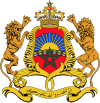
Tourism in Morocco is well developed, maintaining a strong tourist industry focused on the country's coast, culture, and history. The Moroccan government created a Ministry of Tourism in 1985.[1] Tourism is considered one of the main foreign exchange sources in Morocco and since 2013 it had the highest number of arrivals out of the countries in Africa.[2] In 2018, 12.3 million tourists were reported to have visited Morocco.[3]
History of tourism[edit]

In the second half of the 1980s and the early 1990s, between 1 and 1.5 million Europeans visited Morocco. Most of these visitors were French or Spanish, with about 100,000 each from Britain, Italy, Germany, and the Netherlands. Tourists mostly visited large beach resorts along the Atlantic coast, particularly Agadir. About 20,000 people from Saudi Arabia visited, some of whom bought holiday homes. Receipts from tourism fell by 16.5% in 1990, the year the Gulf War began. In 1994, Algeria closed its border with Morocco after the Marrakech attack, which caused the number of Algerian visitors to fall considerably; there were 70,000 visitors in 1994 and 13,000 in 1995, compared to 1.66 million in 1992 and 1.28 million in 1993. In 2017, there were 10.3 million tourist arrivals, compared with about 10.1 million in 2016, a 1.5% year-over-year increase. 30% of the tourists were one of the 3.8 million Moroccans living abroad. Marrakech itself had over 2 million visitors in 2017.[4] In 2019, more than 13 million tourists visited Morocco. In 2020, Morocco witnessed an all time low with no more than 4 million tourists, due to the spread of the COVID-19.[5] In 2023, Marrakech was voted a Top 10 Best Destinations for International Tourists by Tripadvisor.[6] In 2023, Morocco set a new record for the number of tourists visiting, reaching 13.2 million, breaking the former record of 12.9 million that was set in 2019.[7]
Tourism industry[edit]

Tourist receipts in 2007 totaled US$7.55 billion. Tourism is the second largest foreign exchange earner in Morocco, after the phosphate industry. The Moroccan government is heavily investing in tourism development.[8] A new tourism strategy called Vision 2010 was developed after the accession of King Mohammed VI in 1999. The government targeted that Morocco will have 10 million visitors by 2010, with the hope that tourism will then have risen to 20% of GDP. Government-sponsored marketing campaigns to attract tourists advertised Morocco as a cheap, exotic, and safe place for European tourists.[citation needed]
Morocco's relatively high number of tourists has been aided by its location, tourist attractions, and relatively low price. Cruise ships visit the ports of Casablanca and Tangier. Morocco is close to Europe and attracts visitors to its beaches. Because of its proximity to Spain, tourists in southern Spain's coastal areas take one- to three-day trips to Morocco. Marrakesh and Agadir are the top two destinations in the country.[3] Air services between Morocco and Algeria have been established, many Algerians have gone to Morocco to shop and visit family and friends. Morocco is relatively inexpensive because of the interesting dirham exchange rate compared to major currencies and the increase of hotel prices in neighborhood Spain. Morocco has an excellent road and rail infrastructure that links the major cities and tourist destinations with ports and cities with international airports. Low-cost airlines offer cheap flights to the country.
Plan Azur[edit]
The "Plan Azur", is a large-scale project initiated by King Mohammed VI, is meant to provide for creating six coastal resorts for holiday-home owners and tourists (five on the Atlantic coast and one on the Mediterranean), the Daily Telegraph noted. The plan also includes other large-scale development projects such as upgrading regional airports to attract budget airlines, and building new train and road links. Through these efforts the country achieved an 11% percent rise in tourism in the first five months of 2008 compared with the same period the previous year, it said, adding that French visitors topped the list with 927,000 followed by Spaniards (587,000) and Britons (141,000). Morocco, which is close to Europe, has a mix of culture and the exotic that makes it popular with Europeans buying holiday homes.[citation needed]
Tourist attractions[edit]
 |
 |
 |
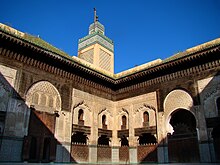 |
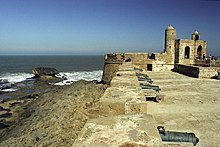 |
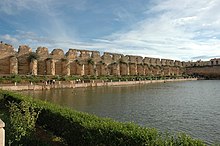 |
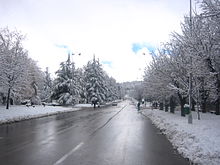 |
 |
 |
The country's attractions can be divided into seven regions:[9]
- The four Imperial cities — the four historical capital cities of Morocco: Fez, Marrakesh, Meknes and Rabat
- Casablanca — Morocco's largest city; home of the Hassan II Mosque, which has the world's second tallest minaret at 656 feet[10]
- Tangier and the surrounding area
- Ouarzazate — a noted film-making location; the fortified village (ksar) of Ait Benhaddou west of the city is a UNESCO World Heritage Site[11]
- Agadir and its beach resorts
- Tarfaya and its beach resorts
- Fez – Morocco's second largest city and it is the science and spiritual capital of Morocco.[12] It contains an old area which is considered the biggest area in the world where vehicles can't get in. It is also the home of "Al Qarawyien" the world's oldest university.
- Merzouga – Merzouga is a small village in southeastern Morocco, about 35 km (22 mi) southeast of Rissani, about 55 km (34 mi) from Erfoud and about 50 km (31 mi) from ...
- Agafay – The Agafay desert is a desert located about thirty kilometers from the red city of Marrakech, on the first heights of the High Atlas massif in Morocco. This is a reg which extends over several hundred hectars. It is covered with stones and rocks in a hilly environment made up of dunes with white and ocher tones.
While Morocco was a French Protectorate (from 1912 to 1956) tourism was focused on urban areas such as the Mediterranean cities of Tangier and Casablanca. Tangier attracted many writers, such as Edith Wharton, Jack Kerouac, Paul Bowles, and William S. Burroughs. There was a period of beach resort development at places such as Agadir on the Atlantic coast in the 1970s and 1980s.[13]
Tourism is increasingly focused on Morocco's culture, such as its ancient cities. The modern tourist industry capitalizes on Morocco's ancient Roman and Islamic sites, and on its landscape and cultural history. 60% of Morocco's tourists visit for its culture and heritage.[13]
Agadir is a major coastal resort and has a third of all Moroccan bed nights. It is a base for tours to the Atlas Mountains.[9] Other resorts in north Morocco are also very popular.[14] Casablanca is the major cruise port in Morocco, and has the best developed market for tourists in Morocco.[9]
As of 2006, activity and adventure tourism in the Atlas and Rif Mountains are the fastest growth area in Moroccan tourism. These locations have excellent walking and trekking opportunities from late March to mid-November.[13] The government is investing in trekking circuits. They are also developing desert tourism in competition with Tunisia.[13]
UNESCO World Heritage Sites[edit]
Morocco is home to nine UNESCO World Heritage Sites.
| Site | Image | Location | Criteria | Area ha (acre) |
Year | Description |
|---|---|---|---|---|---|---|
| Medina of Fez | 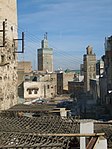 |
Fez | Cultural: (ii), (v) |
280 (690) | 1981 | The former capital was founded in the 9th century and features the world's oldest university. The urban fabric and main monuments date from the 13th and 14th centuries.[15] |
| Medina of Marrakesh | 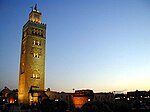 |
Marrakesh | Cultural: (i), (ii), (iv), (v) |
1,107 (2,740) | 1985 | The town was founded in the 1070s and remained a political, economic, and cultural centre for a long time. Monuments from that period include the Koutoubia Mosque, the kasbah, and the battlements. The city also holds newer features, including palaces.[16] |
| Ksar of Ait-Ben-Haddou | 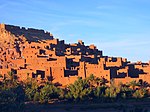 |
Aït Benhaddou (Ouarzazate Province) |
Cultural: (iv), (v) |
3 (7.4) | 1987 | The ksar is an example of a traditional pre-Saharan habitat, surrounded by high walls and reinforced with corner towers.[17] |
| Historic City of Meknes | 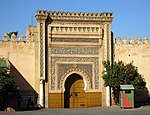 |
Meknes | Cultural: (iv) |
— | 1996 | The former capital was founded in the 11th century and turned into a city with Spanish-Moorish influence during the 17th and 18th centuries.[18] |
| Archaeological Site of Volubilis |  |
Meknes | Cultural: (ii), (iii), (iv), (vi) |
42 (100) | 1997 | The important Roman outpost of Volubilis was founded in the 3rd century BCE to become the capital of Mauritania. It contained many buildings, the remains of which have survived extensively to this day.[19] |
| Medina of Tétouan (formerly known as Titawin) | 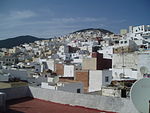 |
Tétouan | Cultural: (ii), (iv), (v) |
7 (17) | 1997 | Morocco's most complete medina served as the main point of contact between Morocco and Andalusia during the 8th century. The town was rebuilt by Andalusian refugees following the reconquista.[20] |
| Medina of Essaouira (formerly Mogador) |  |
Essaouira | Cultural: (ii), (iv) |
30 (74) | 2001 | The fortified seaport built during the late 18th century has a mix of North African and European architecture, and was a major trading hub between the Sahara and Europe.[21] |
| Portuguese City of Mazagan (El Jadida) |  |
El Jadida | Cultural: (ii), (iv) |
8 (20) | 2004 | The fortification, akin to Renaissance military design from the early 16th century, was taken over by Morocco in 1769. Surviving buildings include the cistern and a Gothic church.[22] |
| Rabat, modern capital and historic city |  |
Rabat | Cultural: (ii), (iv) |
349 (860) | 2012 | Rebuilt under the direction of the French from 1912 to the 1930s, the city blends historic and modern features, such as botanical gardens, the Hassan Mosque, and the remnants of Moorish and Andalusian settlements from the 17th century.[23] |
Fez[edit]

Fez was the capital city of modern Morocco until 1925 and is now the capital of the Fès-Meknès administrative region. The city has two old medina quarters, the larger of which is Fes el Bali. It is listed as a World Heritage Site and is believed to be one of the world's largest urban pedestrian zones (car-free areas).[24] University of Al Quaraouiyine, founded in 859, is the oldest continuously functioning university in the world.[25][26] The city has been called the "Mecca of the West" and the "Athens of Africa", a nickname it shares with Cyrene in Libya.[27]
Fez is a popular tourist destination and many non-Moroccans are now restoring traditional houses (riads and dars) as second homes in the Fez medina. The most important monuments in the city are:
- Bou Inania Madrasa
- Al-Attarine Madrasa
- University of Al Quaraouiyine
- Zaouia Moulay Idriss II
- Dar al-Magana
- Ibn Danan Synagogue

Marrakesh[edit]
Marrakech in central Morocco is a popular tourist destination, but is more popular among tourists for one- and two-day excursions that provide a taste of Morocco's history and culture.[14] The Majorelle botanical garden in Marrakech is a popular tourist attraction. It was bought by the fashion designer Yves Saint-Laurent and Pierre Bergé in 1980. Their presence in the city helped to boost the city's profile as a tourist destination.[28]
 |
 |
 |
Tangier[edit]
Tangier, formerly the International Zone from 1923 to 1956, is a city in north of Morocco. Formerly part of the Spanish Protectorate in Morocco, Tangier is a blend of Spanish, Moroccan, and Berber cultures. Famous tourist sites in the city and near it include the Tangier-American Legation, Hercules Cave, the Kasbah museum, the Perdicaris Parc, the Musée de Carmen-Macein, Museum of Moroccan Arts and Antiquities, Museum of Contemporary Art, the Grand Socco, the Petit Socco, and Gran Teatro Cervantes.
El Jadida[edit]

El Jadida, formerly called Mazagan by the Portuguese, was registered as a UNESCO World Heritage Site in 2004, on the basis of its status as an "outstanding example of the interchange of influences between European and Moroccan cultures" and as an "early example of the realisation of the Renaissance ideals integrated with Portuguese construction technology". According to UNESCO,[29] the most important buildings from the Portuguese period are the cistern, and the Manueline Church of the Assumption. El Jadida is also home to the annual Salon du Cheval–the largest horse expo in Africa.[30]
Safety[edit]
Caution is advised[31] due to terrorism. Recent examples are April 2011 terrorist attacks in Marrakesh, the Murders of Louisa Vesterager Jespersen and Maren Ueland in Imlil December 2018. Morocco is a relatively safe country.
See also[edit]
- Economy of Morocco
- Investment in Morocco
- Museums in Morocco
- Plan Azur
- Surfing in Morocco
- Visa policy of Morocco
References[edit]
- ^ Hudman, Lloyd E.; Jackson, Richard H. (2003). Geography of Travel & Tourism. Cengage Learning. ISBN 0766832562.
- ^ "The Most Visited Countries in Africa".
- ^ a b Bazza, Tarek (2019-01-23). "Over 12 Million Tourists Visited Morocco in 2018, Up 8% from 2017". Morocco World News. Retrieved 2019-03-21.
- ^ "Tourism in Marrakech Breaks All Records in 2017". 2018-01-02.
- ^ AfricaNews (2022-02-12). "Morocco tourism sector struggles to pick up days after reopening". Africanews. Retrieved 2023-01-24.
- ^ Rahhou, Jihane. "Marrakech Features on Top 10 Best Destinations for International Tourists". moroccoworldnews. Retrieved 2023-01-24.
- ^ "Morocco sets new record for tourist arrivals in November 2023". HESPRESS English - Morocco News. 2023-12-14. Retrieved 2023-12-15.
- ^ "Inspiring a tourism revolution in Morocco". www.worldfinance.com. Retrieved 2019-03-21.
- ^ a b c Hudman, Lloyd E. (2002). Geography of Travel & Tourism. Thomson Delmar Learning. p. 367. ISBN 0-7668-3256-2.
- ^ Museyon (2009-06-01). Film + Travel Asia, Oceania, Africa: Traveling the World Through Your Favorite Movies. Museyon. ISBN 9781938450341.
- ^ "You're Not a World Traveler Until You Visit these UNESCO sites". pastemagazine.com. Retrieved 2017-11-22.
- ^ Gilbert, Sarah (2017-07-25). "Fez's medina gets new riads, restaurants and restored monuments". The Guardian. ISSN 0261-3077. Retrieved 2017-11-22.
- ^ a b c d Shackley, Myra (2006). Atlas of Travel And Tourism Development. Butterworth-Heinemann. pp. 43–44. ISBN 0-7506-6348-0.
- ^ a b The Middle East and North Africa 2003. Europa Publications, Routledge. 2002. p. 863. ISBN 1-85743-132-4.
- ^ "Medina of Fez". UNESCO. Retrieved 28 May 2010.
- ^ "Medina of Marrakesh". UNESCO. Retrieved 28 May 2010.
- ^ "Ksar of Ait-Ben-Haddou". UNESCO. Retrieved 28 May 2010.
- ^ "Historic City of Meknes". UNESCO. Retrieved 28 May 2010.
- ^ "Archaeological Site of Volubilis". UNESCO. Retrieved 28 May 2010.
- ^ "Medina of Tétouan (formerly known as Titawin)". UNESCO. Retrieved 28 May 2010.
- ^ "Medina of Essaouira (formerly Mogador)". UNESCO. Retrieved 28 May 2010.
- ^ "Portuguese City of Mazagan (El Jadida)". UNESCO. Retrieved 28 May 2010.
- ^ "Rabat, modern capital and historic city: a shared heritage". UNESCO. Retrieved 30 June 2012.
- ^ Mother Nature Network, 7 car-free cities
- ^ Oldest University
- ^ "Medina of Fez". UNESCO World Heritage Centre. UNESCO. Retrieved 7 April 2016.
- ^ History of Fes Archived 2011-03-16 at the Wayback Machine
- ^ Mortraveling (2022-04-01). "Thematic itineraries in Morocco". Retrieved 2022-04-01.
- ^ "Portuguese City of Mazagan (El Jadida) – UNESCO World Heritage Centre". Whc.unesco.org. Retrieved 2013-02-10.
- ^ "Le Salon du Cheval d'El Jadida: 11 ans déjà!". 2M (in French). Retrieved 2019-03-21.
- ^ "Morocco Travel Advisory". U.S. Department Of State. 2022-10-05. Retrieved 2022-11-22.
